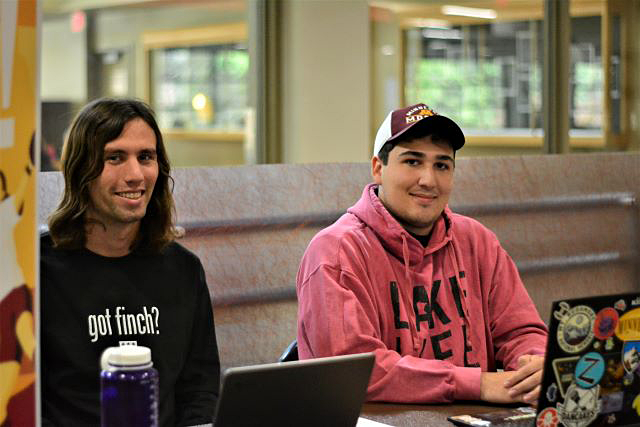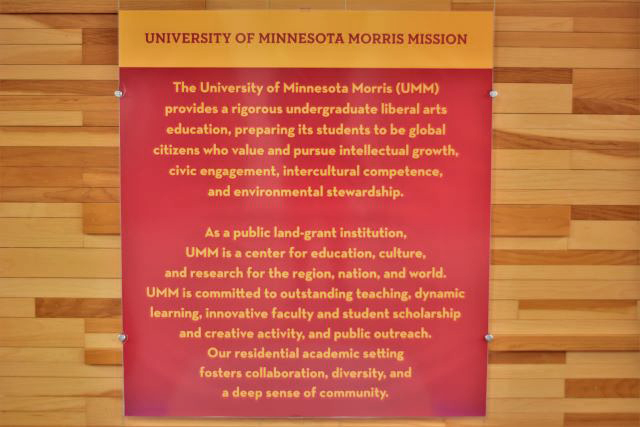I asked the question in a couple of different ways to several students at the University of Minnesota Morris, but regardless of how the question was posed, the answers seemed to have a uniformity to them.
The questions posed were, “What is ‘too diverse?’” and “What did you think when you heard a regent of the University of Minnesota said a problem with UMN Morris is it may be ‘too diverse?’”
At least two of the answers elicited a variant of the same cuss word … the “F” word.
“I have no f*cking clue what that even means; ‘too diverse,’” said Dylan Young a fourth year student at Morris and president of the Morris Campus Student Association.
“That’s f*cked up. That’s what I thought,” said Ryan Sajulga, a second year student at Morris.
The visceral reactions are understandable.
After all, as students of color Young, who is Native American and Sajulga, who is Filipino, are part of the “problem” as seen by University of Minnesota Regents Vice Chair Steve Sviggum. Sviggum let his feelings on Morris’ declining enrollment be known during an Oct. 13 meeting of regents when he asked if the campus was “too diverse” and that supposed diversity makes prospective students “uncomfortable.”
But it is Sajulga who said he is now the uncomfortable one after hearing Sviggum’s comments.
“I feel unsafe and unwanted. I feel like I don’t belong,” said Sajulga, who plays tennis for the university.

Mercedese Young Man said she often feels alone on the campus and in the western Minnesota town.
“I feel isolated,” said Young Man, who is in her first semester at Morris. “Before (Sviggum) said all of that I was going to my counselors and telling them I was having a hard time adjusting to being here.”
Young Man, who sat for nearly an hour by herself in the school café seating area, said she transferred to Morris because of its supposed diversity, but she said that’s not the case. Officially Morris can boast of a robustly diverse population – 41% students of color, of that 32% Native American of a total student population of 1,068 – but Young Man disputed those numbers.
“There are just a handful of Native students here and all from separate tribes,” said Young Man, who is from Oglala, South Dakota. “In several of my classes I’m the only person … maybe one other … person of color.”
The only one
For four years Biruk Mengistu has been subjected to being the “only one.”

“Wait, what’s the photo for, maybe I don’t want to be in it,” quizzed Mengistu.
When informed of the purpose for the photo Mengistu replied, “Oh, I definitely want to be in that photo.” And he echoed the sentiments of Young Man of being isolated and alone.
“It’s absolutely absurd (that UMN Morris) is too diverse. It’s the exact opposite. While the people here (on campus) are welcoming and I feel loved, we definitely need more diversity. I’ve been the only Black student in most of my classes. This year it’s getting better, but during COVID I felt like to only one on campus for sure.”
Mengistu said the comments of the vice chair of the Board of Regents evoked emotions of shock and fear.
“It’s scary that someone in power has that point of view,” said Mengistu.
“That point of view” caused Gearou, who plays both tennis and soccer for UMN Morris, to question, “What does he (Sviggum) want for our (campus) community? Wouldn’t you want a diverse community?”
The road to Morris
Morris, Minnesota is about two and a half hours west of Minneapolis. The ride up Interstate 94 through St. Cloud is pretty typical interstate travel. Mostly unremarkable. I was hoping to at least see a deluge of trees turning their beautiful fall orange, yellow and red, but I guess I was expecting too much. That said, I certainly preferred the bland landscape of interstate travel over the travel along Minnesota Highway 28, a two-lane highway dotted with farmland and just a few residential homes, with the exception of a picturesque town called Glenwood, Minnesota. Thankfully I was traveling on a clear, sunny day. I didn’t know how long I was going to stay in Morris, but once I turned off onto MN 28 I made the decision to return home well before dark. The mere thought of travel as a Black person along a lonely, dark road in rural America triggered a mini anxiety attack. Turning off onto the road leading to the college and being greeted by an outdoor gun range just .04 miles from the school’s entrance only heightened my anxiety.
According to the U.S. Census Bureau, Morris is a town of 5,206 residents. Eighty-six percent of them are white, 6.3% Hispanic, 3.4% Asian, 2.7% Black and 1.9% Native American … far from “too diverse.” Much of the town’s commercial fare is along Atlantic Avenue, including a couple of eateries and a watering hole. According to the students with whom I interacted, there’s not much of a social scene off campus and sometimes being off campus makes students feel a bit uneasy.
“A few Native students will try to go to the bars, but they won’t take our tribal IDs,” said Young Man. “And that’s crazy. Our IDs are federally issued and they won’t take them.”
Most students see the university as a safe haven; a place of tranquility and peace. A modest campus, the University of Minnesota Morris offers a smattering of buildings encasing the school’s quadrangle. Noticeably quiet, the primary sound for most of my time in the quad was of the American flag’s metal rings rapping against the tall pole placed almost equidistant center of the square.
Inside the student center Grant Strukel and Dawson Kadlec were hoping to entice students to sign-up for intermural sports. Activity at their table, like throughout the campus, was sparse. When asked if they had heard of the regent’s comments, both shook their heads left to right, which usually means “no,” but their facial expressions let me know that the shaking of the head wasn’t because they didn’t know, it was because they didn’t approve.
Strukel said contrary to being the problem, UMN Morris’ diversity was a selling point.

“That doesn’t even make sense that a liberal arts school is ‘too diverse.’ And that two people bringing it up was enough to respond was appalling,” said Kadlec. (Sviggum said he received two letters from parents of prospective students who said campus diversity was the reason they chose against Morris). “On the Twin Cities campus you see a lot more diversity than here, so it’s shocking to say something about such a small campus.”
While statistically, the University of Minnesota’s Twin Cities campus is less diverse than Morris (undergraduate population 64.5% white, 10.5% Asian, 5.1% Black, 4.5% Hispanic), due to size there are more Black students at the Twin Cities campus (1,515) than Morris’ total enrollment.
Calls for Sviggum to resign
Several, including the University of Minnesota Clerical Workers union, have called on Sviggum to immediately resign. Others have strongly condemned his remarks.
A letter signed by more than 100 UMN Morris faculty and staff admonished the regent, saying his comments were “grounded in an unstated, yet no less real, fear of racial and ethnic diversity generally and people of color specifically” and “by connecting enrollment issues to demographics, Sviggum is inaccurately faulting students of color rather than addressing the well-documented marginalization and inequities these students face.” The letter goes on to ask what type student would be offended by a diverse student population.

Sviggum did issue an apology, sent through the University of Minnesota Public Relations department.
“Let me unequivocally apologize for my questions, and especially for the unintended hurt my questions may have caused. They were not intended to cause harm, but my intent does not matter. For those whom I have harmed or offended, and for all of those associated with our great university, I am truly sorry,” Sviggum said in his statement. “… My intent – recognizing that my words matter – was to foster discussion around the consistently declining enrollment at Morris, which is not a one-year trend or even a concern that has emerged out of the COVID pandemic. Rather, student enrollment has been declining for years (down 50% from its peak) and the future of this great campus depends on finding solutions to reverse that trend.”
MinnPost reached out to Sviggum for comment, but he did not reply to our requests.
A unique and troubled history
Just to the right of where Strukel and Kadlec were seated is a display case chronicling the history of UMN Morris. A photo in the case is accompanied by text “In the 1890s the Bureau of Indian Affairs wanted American Indians to become exactly like the rest of the white population.” The text goes on to tell the story of how a boarding school was established on the site of the campus in attempts to achieve that dubious goal. The school closed in 1909 and was transferred to the state of Minnesota, but it was stipulated that Native American students “shall at all times be admitted to such school free of charge for tuition.” UMN Morris continues to honor the stipulation.
Though not free, others such as Strukel and Kadlec cited low cost of tuition as a reason they chose to attend UMN Morris, where annual estimated costs including housing and books is around $26,000. Costs at the Twin Cities campus comes in at about $31,000. Add an additional $2,500 for certain schools within the university’s Twin Cities campus such as Carlson School of Management and the College of Science and Engineering Studies.

“We’re unique here because we’re so separated from the fast-paced world. Here it’s who’s around you; that’s who you got,” said Kadlec. “There’s no Target or Walmart here to take my money so I’m forced to be here on campus with my friends; and that’s not bad at all.”


0 Commentaires